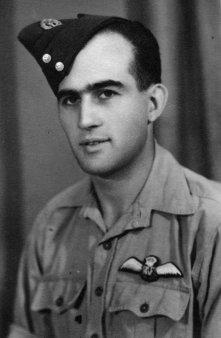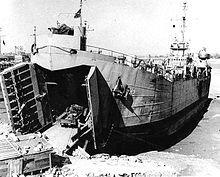
Wartime Heritage
ASSOCIATION


Ronald Gaudet

copyright © Wartime Heritage Association
Website hosting courtesy of Register.com - a web.com company
January 1945
By Ronald Gaudet
My Years in the Royal Canadian Air Force
Pilot Officer Ronald Gaudet
January 1945
Pilot Officer Ron Gaudet moved to Hornchurch in England on January 1, 1945 and
boarded an L.S.T. [tank landing ship] the next day for Ostend, Belgium on route to the
Canadian aerodrome Evere, near Brussels.
The first day or so had quite a fight to keep from being sick as this thing rolled,
slid, and pitched all at the same time. I would stay in the Officers mess until I felt too
bad and go up on deck in the fresh air but it was pretty cold to stay too long. On one of
these trips a sailor came by and asked if I was all right and I told him I didn't feel too hot
but had not thrown up yet. He told me not to feel too bad as he had sailed the seven seas
in different ships with no problem but the first three days aboard this he thought he was
going to die and wished he would.
We ran into a storm and lay off Ostend for 36
hours and docked on January 5, 1945. I could see why
they could not go in if it was rough as the enemy had
sunk a ship across the opening and the Engineers had
just blown a hole through the hulk so it was not much
wider than the ship. I arrived on the Squadron the
next day. [Squadron 443]
They informed me that my replacement was shot
down and killed by flak on the way back from an escort. The field was a mess from the
enemy attack on January 1. There here were wrecked kites all over the place. Our
squadron missed this as they were in England at the time. There were three Dakotas
standing side by side. They were used as air-ambulances, and the tail sections of each
were cut off as the bullet holes were touching each other in a line just ahead of the fin.
The tails were laying on their sides leaving the noses pointing to the sky.
The enemy figured everyone would be hung over after New Years Eve and gathered
all the fighter aircraft they could and sent them over at deck level so radar couldn't pick
them up and the ground observers would be too hung over to see them. This happened
and the first target was the control tower at Eindhoven thus knocking out our main
communication lines. After this they hit our field and in the process of this the phone
rang in our Intelligence Office and said it was Control at Eindhoven and we were going to
be attacked as there were some fighters headed our way. The officer replied, "I know
listen to them" and stuck the phone out the window.
I was talking with Mac Reeves a pilot in one of the other Squadrons on our field
about the Jan. 1st. effort. He was on patrol along the bomb line with another Reeves (no
relation) and control called and told them their base was under attack. They headed for
home and when they arrived thought they were over Germany as the circuit was full of
M.E.109's and FW. 190's. They started down and the other Reeves’ engine started to act
up so Mac went down and attacked by himself even though there were 40 or 50 of them.
I can see him now stretched out sitting in a chair smoking a cigar and saying, "I got
three of them before they got away." He came down and got on the tail of a 190 and
pushed the button but the guns didn't fire and realized he forgot to take the safety off so
had to break off. He then shot down a 109 and a 190 then they all started to leave, gas
running low I imagine. He got on the tail of a 190 and chased him at ground level and the
190 drove his nose in the ground and blew up. As Mac put it, "He must have been a green
pilot and turned to look at me and let the stick go forward so I got a destroyed and never
fired a shot”.
A few days later [January 10] another pilot and I were just leaving the latrine and
headed for the mess hall. And suddenly saw a large flame shoot high in the air through
the fog and then a loud blast so we both dropped to the ground as we thought another
January 1 raid.
Just as we stood up again there was a loud crash close to us and then something hit
the blast wall beside my head so we dropped again. After a few seconds got up and there
were two pieces of steaming hot cement that had missed us by a foot in the snow on top
of the wall. There were women screaming in the mess and as we went to go through the
opening to enter the building, we were almost bowled over by Sqn/L. Art Sager and he
said something about a Flying Fortress blowing up on the field and jumped in his Jeep
and drove off.
There was a large hole through the roof of the mess and one window complete with
frame was lying on the ground and another was inside on the floor. I saw this at a glance
and took off for the field to see what was going on. Men were running out of the barracks
and offices with blood running from their faces due to flying glass, all wanting to know
what was happening.
A B17 with a full bomb load was making an emergency landing in the fog and
touched down too late. It tried to go around again but saw he couldn't make it but was
too late to stop. He ran into a concrete hangar and caught fire. One of the men from our
ground crew pulled a few of the crew out and while carrying one of them the whole thing
went up. He was smart enough to keep the side wall between him and the Fortress in the
hangar so was blown off his feet along with the crewman he was carrying but not hurt.
The hangar was flattened along with the aircraft that was in there along with some that
were parked near the site. One of the main wheels was out in the middle of the field
burning.



- World War I - Menu
- WWI Stories and Articles
- Photos - Yarmouth Soldiers
- Selection of World War I Songs
- WWI Casualties of Yarmouth, NS
- Those Who Served - Yarmouth, NS
- WWI Casualties Digby Co. NS
- WWI Casualties Shelburne Co. NS
- Merchant Mariners (1915) Yarmouth, NS
- Canadian Forestry Corps - Non Yarmouth Birth/Residence Enlistments
- US Draft Registry - Yarmouth NS Born


- World War II - Menu
- WWII Stories and Articles
- Telegraphist Air Gunners
- WWII Casualties of Nova Scotia
- US Casualties with NS Connection
- Far East/Pacific Casualties with NS Connection
- Merchant Navy Casualties Nova Scotia
- Nova Scotia WWII Casualties Holten Canadian War Cemetery
- D-Day Casualties - Nova Scotia
- CANLOAN Program Casualties - Nova Scotia
- Battle of the Bulge Casualties - Nova Scotia
- WWII Casualties Yarmouth NS
- Yarmouth Casualties - RCAF RAF Canadian Army WWII
- Yarmouth Co., Marrages WWII
- Casualties Non-Born/Residents with Connection to Yarmouth Co., Nova Scotia.
- WWII Casualties Digby Co., NS
- Non-Nova Scotian WWII Casualties Buried in Nova Scotia
- WWII RCAF Casualties Aged 16-18
- Brothers/Sisters Who Served - World War II













